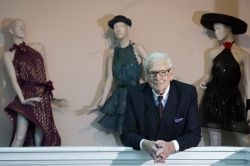Eternal futurist of fashion Pierre Cardin opens new museum at 92

One of the last survivors of the great post-war French fashion houses, Cardin, at 92, still heads a sprawling business empire.
“Back then I hadn’t yet become Pierre Cardin. I hadn’t found my voice,” he says, in uncharacteristically reflective mood.
The avant-garde designer, known for his geometric shapes, dresses decorated with circular and rectangular motifs and astronaut’s headgear, has always tended to look forward rather than backward. But he is making an exception today.
His Past-Present-Future museum, until recently tucked away in a far-flung corner of the Paris suburbs, is reopening in the more central Marais, the city’s historic former Jewish quarter.
The exhibit traces Cardin’s 60-year career through some 200 fashion pieces, as well as hats, shoes, pieces of jewellery and furniture.
– ‘Came from nothing’ –
The son of parents who settled in France in 1924 after escaping Italy’s fascist regime, Cardin says the museum will deliver a “legacy for a couturier who came from nothing”.
As successful in business as was in fashion, Cardin started work as an apprentice at 14, moving to Paris after World War II where he worked at the Paquin and Schiaparelli fashion houses before joining Christian Dior.
In 1950, having failed to get a job with Balenciaga, he decided to set up on his own.
“I had the chance to achieve everything I wanted without needing a banker, authority… I was a free man from the age of 20,” he recalls.
His 1964 “Space Age” collection remains a landmark in fashion history with its cut-out dresses, knitted catsuits, tight leather pants, close-fitting helmets and batwing jumpers.
“Only lines count. I only care for simplicity,” he once wrote. For style to become real, proportion and line are primordial.”
Cardin, who will inaugurate the 1,000-square-metre (10,000-square-foot) museum on Thursday, was also one of the earliest believers in ready-to-wear.
After launching his first ready-to-wear collection in 1959, he was promptly expelled from Paris’s association of haute couturiers.
But the new trend for more accessible fashion was an unstoppable force and he was later readmitted.
– Inexhaustible –
Today, despite being in his tenth decade, Cardin remains inexhaustible.
His many business acquisitions take in hotels, factories, boutiques and restaurants, including Paris’s upmarket eaterie Maxim’s which he turned into an international chain with branches all over the world.
In 2011, he put his fashion label — made up of some 300 licence contracts — up for sale saying he hoped it would fetch up to a billion euros.
His property projects, however, have sometimes been controversial.
His attempts to build a golf course on land he owned in the south of France were eventually scuttled following local protests.
And, in 2013, he had to abandon his plan for a futuristic billion-euro tower in the Venice lagoon amid warnings it would destroy the city’s skyline.
“I’ve always had bizarre ideas that surprise, but this is what makes my personality,” he says.
Even now, Cardin continues to design for the catwalks from time to time.
“It’s youth that makes fashion, not old people. Me, I’m one of the old people now — but I have stayed young,” he says.
He does not mention any of the younger generation of designers as heirs, though, and appears to regret what he perceives as a loss of distinctiveness.
“Fashion design is so diverse. It does not have clear identities as before with Balenciaga, Chanel, Cardin, Courreges. Design is about being recognised without a label. Elegance alone is not sufficient,” he says.
Still busy with his own business empire, however, he is happy to remain largely detached from the rest of the fashion world.
“I don’t see the other designers. I have so much to do personally,” he says, adding: “I don’t have to judge them… they have their work and I have mine.”
alm-har /ns

